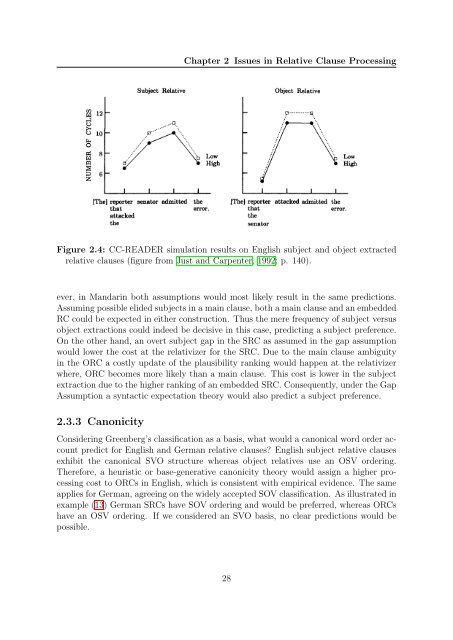Connectionist Modeling of Experience-based Effects in Sentence ...
Connectionist Modeling of Experience-based Effects in Sentence ...
Connectionist Modeling of Experience-based Effects in Sentence ...
Create successful ePaper yourself
Turn your PDF publications into a flip-book with our unique Google optimized e-Paper software.
Chapter 2 Issues <strong>in</strong> Relative Clause Process<strong>in</strong>g<br />
140 MARCEL ADAM JUST AND PATRICIA A. CARPENTER<br />
fc<br />
o<br />
H<br />
03<br />
Subject Relative<br />
I I I I<br />
[The] reporter senator admitted the<br />
that error,<br />
attacked<br />
the<br />
SIMULATION<br />
Object Relative<br />
a- B<br />
I I I<br />
[The] reporter attacked admitted the<br />
that error,<br />
the<br />
senator<br />
Figure 2.4: CC-READER simulation HUMAN results DATA on English subject and object extracted<br />
relative clauses (figure from Just and Carpenter, 1992; p. 140).<br />
Subject Relative<br />
Object Relative<br />
900<br />
Lowa<br />
ever, <strong>in</strong> Mandar<strong>in</strong> both assumptions would most likely result <strong>in</strong> the same predictions.<br />
Assum<strong>in</strong>g800 possible elided subjects <strong>in</strong> a ma<strong>in</strong> clause, both a ma<strong>in</strong> P'' clause and an embedded<br />
Low<br />
RC could be expected <strong>in</strong> either construction. Thus the mere frequency High <strong>of</strong> subject versus<br />
OH 700<br />
object Ed extractions could <strong>in</strong>deed be decisive <strong>in</strong> this case, predict<strong>in</strong>g a subject preference.<br />
On the other 600 hand, an overt subject gap <strong>in</strong> the SRC as assumed <strong>in</strong> the gap assumption<br />
would olower<br />
the cost at the relativizer for the SRC. Due to the ma<strong>in</strong> clause ambiguity<br />
2<br />
<strong>in</strong> the R ORC 500 a costly Highupdate<br />
<strong>of</strong> the plausibility rank<strong>in</strong>g would happen at the relativizer<br />
where, ORC becomes more 1 j_ likely i than I a ma<strong>in</strong> clause. This cost is lower I I I <strong>in</strong> the subject<br />
extraction[The] duereporter to thesenator higheradmitted rank<strong>in</strong>gthe <strong>of</strong> an embedded [The] reporter SRC. attacked Consequently, admitted theunder<br />
the Gap<br />
Assumption W athat syntactic expectationerror, theory wouldthat also predict a subject error. preference.<br />
S<br />
attacked<br />
the<br />
2.3.3 Canonicity<br />
the<br />
senator<br />
Figure 9. The number <strong>of</strong> cycles expended on various parts <strong>of</strong> the subject-relative sentences (on the left)<br />
and object-relative sentences (on the right) when the simulation, CC READER, is operat<strong>in</strong>g with more or<br />
less work<strong>in</strong>g memory capacity. (The bottom graph presents the human data for comparison with the<br />
simulation.)<br />
Consider<strong>in</strong>g Greenberg’s classification as a basis, what would a canonical word order account<br />
predict for English and German relative clauses? English subject relative clauses<br />
exhibit the canonical SVO structure whereas object relatives use an OSV order<strong>in</strong>g.<br />
Therefore, a heuristic or base-generative canonicity theory would assign a higher pro-<br />
Pragmatic Influence on Syntactic Process<strong>in</strong>g<br />
cess<strong>in</strong>g cost to ORCs <strong>in</strong> English, which is consistent with empirical evidence. The same<br />
applies for German, agree<strong>in</strong>g on the widely accepted SOV classification. As illustrated <strong>in</strong><br />
example (13) German SRCs have SOV order<strong>in</strong>g and would be preferred, whereas ORCs<br />
have an OSV order<strong>in</strong>g. If we considered an SVO basis, no clear predictions would be<br />
low span simulation, which has a smaller activation maximum.<br />
The words that follow the verbs evoke fewer productions, so<br />
even though the activation maximum applies dur<strong>in</strong>g their fir<strong>in</strong>g,<br />
they complete their execution <strong>in</strong> a smaller number <strong>of</strong> cycles<br />
(compared with the verb process<strong>in</strong>g), and the high-low difference<br />
becomes smaller.<br />
In summary possible. a simulation that varies the amount <strong>of</strong> activation<br />
available for simultaneously comput<strong>in</strong>g and mn<strong>in</strong>tatMng<br />
<strong>in</strong>formation accounts for the read<strong>in</strong>g time differences between<br />
high and low span subjects deal<strong>in</strong>g with syntactic complexity<br />
provided by center-embedded clauses.<br />
The simulation demonstrates how the contribution <strong>of</strong> a pragmatic<br />
cue to syntactic aaatyas depends on an adequate supply<br />
<strong>of</strong> activation. Fust consider the simaJation <strong>of</strong> the high span<br />
subjects (<strong>in</strong> which the activation maximum is relatively high) <strong>in</strong><br />
process<strong>in</strong>g the sentences conta<strong>in</strong><strong>in</strong>g reduced relative clauses.<br />
The <strong>in</strong>animacy <strong>in</strong>formation encoded with the subject noun<br />
"evidence") is still <strong>in</strong> an activated state whea the verb is<br />
be<strong>in</strong>g processed, and this <strong>in</strong>formation is used to select between<br />
the two <strong>in</strong>terpretations <strong>of</strong> the verb (past tense vs. past partici-<br />
28
















